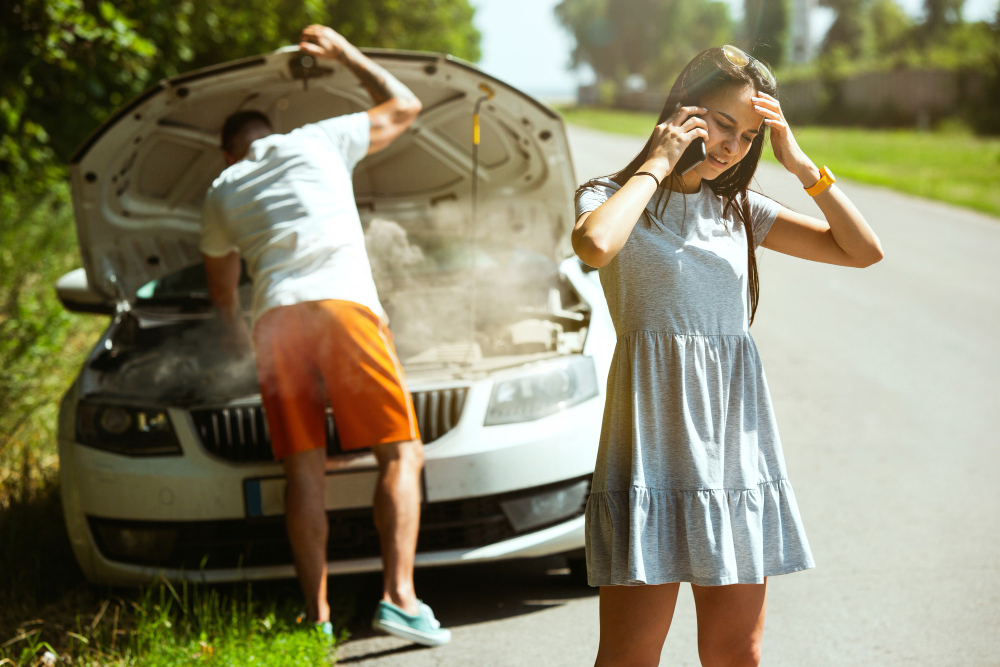A vehicle breakdown can be a disruptive and stressful event. However, prioritizing personal safety is important during such situations. While roadside assistance programs offer invaluable support, implementing specific measures can significantly enhance your security while awaiting help. This article outlines key strategies to safeguard yourself on the roadside.
Prioritizing Safe Vehicle Positioning
Strategic Pullover
The initial action should be to maneuver your vehicle off the main travel lane. If possible, find a well-illuminated shoulder with ample space. Aim for designated rest areas on highways for optimal safety.
Enhancing Visibility
Hazard Light Activation
Once your vehicle is safely maneuvered to a stop, the first thing you will do is turn the hazard lights on. Such an important measure is a lucid signal to oncoming drivers of your vehicle’s disablement. By turning on your hazards at this time, you are significantly improving the safety of the side of the road. Ample warning time is given to let others change their speed or make certain they navigate safely around your stopped car.
Deployment of Warning Devices
If you possess reflective triangles or flares, strategically place them a safe distance behind and in front of your car, adhering to the manufacturer’s instructions. This is particularly needed in low-light conditions.
Maintaining Secure Vehicle Occupancy
Interior Refuge
While you are waiting for help, ensure your personal safety by remaining in your car. Keep the windows rolled up and your doors locked. This creates a physical barrier between yourself and anyone who might mean to do you harm. This one simple trick provides a very important layer of security that not only gives you peace of mind but also time for evaluation. Remember, staying inside your locked car is the safest course of action in most roadside emergencies.
Cautious Exits
Only exit the vehicle if the situation absolutely necessitates it. This might be to set up warning devices in unreachable areas or in the case of a fire (in which case, prioritize immediate evacuation to a safe distance). Even when exiting, ensure you do so on the side farthest from traffic.
Prompt Communication for Assistance
Establishing Contact
Use your phone to contact your pre-enrolled roadside service provider. If you lack a roadside service provider, or if the situation falls outside your coverage, call a roadside service or emergency services depending on the severity of the issue.
Detailed Communication
Precise and clear communication is the key when seeking roadside help. First, be sure to tell the dispatcher your exact location, including mile markers, or any close landmarks. Next, give a comprehensive description of the problem being experienced.
The more information you give the dispatcher, the quicker he or she can assess the situation and send the most appropriate assistance. And of course, don’t forget to mention the number of people in your car. This will enable them, though a small detail, to assess the kind of resource people send and keep in mind everyone’s safety.
Maintaining Awareness and Patience
Vigilance
Don’t be lulled into complacency by sitting around and waiting. Keep an eye out for your surroundings; be very vigilant when stuck on the road. Keep your situational awareness by watching your surroundings and any approaching vehicles or people. If, at any moment, you feel unsafe or see something suspicious, do not think twice before calling emergency services. After all, a quick look around can help you identify potential dangers and make sure your case.
Stranger Caution
Avoid approaching or soliciting assistance from strangers. If someone approaches your vehicle, maintain locked doors and rolled-up windows. In situations where you feel unsafe, dial emergency services immediately.
Exercising Patience
Be prepared to wait, because sometimes the response time for roadside assistance could vary due to location and the amount of work they have. Layer up if it’s cold and you’re going to be waiting a while, or use the blankets that are part of the emergency kit in your car.
On the other hand, if the weather is hot, find some shade or use a sunshade on your windows, and drink water from your emergency kit to keep cool. Remember, maintaining comfort can significantly improve your experience while waiting for assistance.
Additional Preparatory Measures
Emergency Kit
Having a well-stocked emergency kit in your car can significantly improve your comfort and safety while waiting for help. Essential items include a flashlight, jumper cables, a first-aid kit, a phone charger, and non-perishable snacks and water.
Programmed Numbers
Proactive planning is the best way out. You need to program the number of your roadside services provider and all the emergency numbers into your phone. Such a simple action will assure you quick and convenient access to help in case you break down. Having these numbers easily accessible can save you precious time and might even help avoid some stress from an already stressful situation.
Key Takeaway
By implementing these proactive strategies, you can significantly enhance your safety and peace of mind while awaiting roadside assistance. Remember, prioritizing your personal security is paramount during any vehicle breakdown situation.



